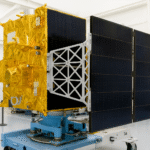Vietnam is stepping into a new era of technological transformation, placing robotics and automation at the center of its modernization strategy. At the National Achievements Exhibition in Hanoi, running from August 28 to September 15, the country is showcasing its progress in robotics, artificial intelligence, and automation. This exhibition highlights how Vietnam is positioning itself as a rising technology hub in Southeast Asia while promoting sustainable economic growth and smart governance.
For Vietnam, robotics is more than just an innovation—it is a tool for improving productivity, enhancing public services, and boosting global competitiveness. The exhibition underscores the government’s commitment to building a future where automation supports both economic development and quality of life.
National Achievements Exhibition: A Window to Modernization
The exhibition has become a key national platform for presenting technological advancements across multiple sectors. It demonstrates how Vietnam is integrating automation into manufacturing, services, and government administration.
Highlights include industrial robots designed to streamline production, service robots that support daily life, and AI-powered tools that improve efficiency in public services. Together, these innovations showcase the government’s broader vision: a Vietnam where digital transformation drives growth and ensures that no sector is left behind.
The emphasis on robotics reflects Vietnam’s determination to embrace Industry 4.0 and become a competitive player in the global digital economy.
Robotics in Industry and Manufacturing
Vietnam is widely recognized as a manufacturing powerhouse, with its economy heavily reliant on exports in textiles, electronics, and consumer goods. Robotics is now playing a vital role in ensuring that the country remains globally competitive.
At the exhibition, industrial robots capable of performing precision assembly, welding, and packaging tasks are on display. These machines are designed to reduce errors, increase productivity, and lower costs—factors critical for companies that compete in international supply chains.
By adopting automation, Vietnam’s manufacturing sector is aligning with global standards while preparing for the demands of future industries. The transition is not only about efficiency but also about creating a modern workforce that can adapt to digital tools and smart factories.
Robots in Public Services and Daily Life
While industrial robots attract attention for their economic benefits, Vietnam is also focusing on how automation can improve daily life for its citizens. One highlight of the exhibition is the deployment of AI-powered service robots in Hanoi’s Cua Nam ward.
These robots assist residents with administrative procedures, reducing waiting times and increasing efficiency. By automating routine tasks, they allow public employees to focus on more complex services while improving overall citizen satisfaction.
This integration of robotics into public administration reflects Vietnam’s commitment to smart governance. It also positions the country as a model for other developing nations seeking to modernize their public service systems through digital transformation.
Economic Growth and Workforce Development
Vietnam’s robotics revolution is about more than just machines—it is about reshaping the economy. The integration of automation into industries is expected to:
- Boost productivity across sectors such as manufacturing, healthcare, and logistics.
- Create skilled jobs in AI development, robotics engineering, and automation management.
- Reduce costs for businesses, making Vietnamese exports more competitive.
At the same time, Vietnam is investing in education and training programs to build a workforce capable of supporting this transformation. Universities and technical schools are expanding programs in robotics engineering and AI, ensuring that the next generation of workers can thrive in a technology-driven economy.
Challenges Ahead in Automation
Despite the optimism, Vietnam faces challenges in implementing robotics and automation on a national scale. One concern is the risk of job displacement, particularly for low-skilled workers in industries where automation is replacing manual tasks.
To address this, policymakers emphasize the importance of balancing automation with job creation. Robots are expected to complement human labor, handling repetitive tasks while workers focus on roles requiring creativity, problem-solving, and innovation.
Another challenge is infrastructure development. To fully support robotics and AI, Vietnam must expand digital infrastructure, including high-speed internet, smart grids, and secure data networks. These investments will ensure that automation can be scaled sustainably across the country.
Robotics as a Pillar of Vietnam’s Global Strategy
Vietnam’s focus on robotics is closely tied to its ambitions to become a global leader in technology and innovation. By showcasing its achievements at the exhibition, the country signals its readiness to compete in an increasingly digital world.
The robotics sector is also expected to strengthen international partnerships. Foreign investors are showing growing interest in Vietnam’s technology industries, drawn by its combination of a young workforce, political stability, and government incentives for innovation.
In addition, Vietnam’s advances in automation complement its progress in artificial intelligence, blockchain, and smart city development, creating a comprehensive ecosystem for digital growth.
A Glimpse into Vietnam’s Digital Tomorrow
The National Achievements Exhibition is more than a display of technological gadgets; it is a vision of Vietnam’s future. From industrial robots that redefine factory floors to service robots that streamline public services, the event demonstrates how innovation is shaping every part of society.
Vietnam’s strategy is clear: embrace robotics and automation as drivers of modernization, economic growth, and global influence. The journey will require overcoming challenges such as workforce adaptation and infrastructure expansion, but the country’s determination is evident.
Conclusion: Vietnam at the Forefront of Innovation
Vietnam’s robotics revolution highlights its ambition to lead Southeast Asia into a digitally connected future. By integrating robots into manufacturing, public services, and daily life, the country is laying the foundation for sustainable growth and global competitiveness.
As seen at the National Achievements Exhibition, Vietnam is not only celebrating its technological achievements but also charting a path toward a future where automation enhances lives, supports industries, and strengthens the nation’s position on the world stage.
With continuous investment in education, infrastructure, and innovation, Vietnam is well on its way to becoming a regional leader in robotics and automation, inspiring other nations to follow its example in embracing the opportunities of the digital age.
For more travel news like this, keep reading Global Travel Wire



















